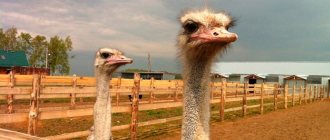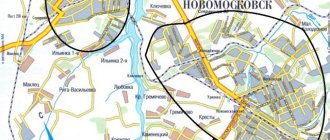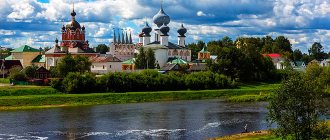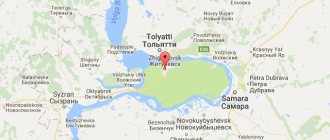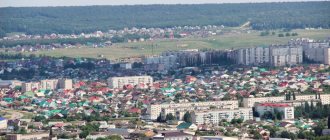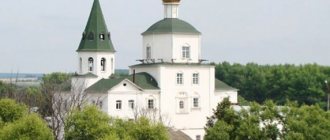| City | |
| Morshansk | |
| 53°27′00″ n. w. 41°48′00″ E. d.HGYAO | |
| A country | Russia |
| Subject of the federation | Tambov Region |
| Urban district | Morshansk city |
| Chapter | Bannikov Alexey Viktorovich |
| History and geography | |
| First mention | 1623 |
| Former names | Morsha |
| City with | 1779 |
| Square | 18.52 km² |
| Center height | 110 m |
| Timezone | UTC+3:00 |
| Population | |
| Population | ↘38,943 people (2018) |
| Density | 2102.75 people/km² |
| Katoykonim | Morshanets, Morshanets |
| Digital IDs | |
| Telephone code | +7 47533 |
| Postcode | 393950-393960 |
| OKATO code | 68420 |
| OKTMO code | 68720000001 |
| promorshansk.ru | |
| Morshansk Moscow Tambov Morshansk | |
| Media files on Wikimedia Commons | |
Morshansk
- a city (since 1779) in the north of the Tambov region of Russia.
The administrative center of the Morshansky district, which is not included, being an administrative-territorial unit of a city of regional significance, forming the municipal formation of the same name, the urban district of the city of Morshansk
.
It is located on both banks of the Tsna River at its crossing by railway, 90 km north of Tambov. The railway station of the same name on the Kuibyshev Railway on the Ryazhsk - Penza line. Population - 38,943 people. (2018).
Content
- 1. History
- 2Population
- 3Economy 3.1Industry
- 3.2Trade
- 3.3Hotels
- 4.1Roads
- 5.1Hospitals
- 7.1 General education
- 11.1Russian Orthodox Church 11.1.1Destroyed churches
- 12.1TV channels
Story
The time of the emergence of a settlement on the site of the city is not precisely established. Morsha village
existed back in the 16th century.
On September 16, 1779, by personal decree of Catherine II, Morsha, the center of grain trade in Tsna, was transformed into the city of Morshansk
, which became a district town. By decree of Catherine II, nobleman Kirill Parshin became the governor of Morshansk.
Market ties expanded and strengthened. Tsna served as the most important trade route. She was navigable from Morshansk. From the Morshansk piers, cargo was sent on barges along the Moksha, Oka, Volga rivers and further along the river systems to St. Petersburg, Rybinsk, Nizhny Novgorod, Moscow, Murom.
Over the course of a year, up to 14 million poods of various cargoes were exported from Morshansk: bread, flour, lard, leather, livestock, hemp, shag. At the same time, stone, salt, and various factory products arrived in Morshansk for transportation by horse-drawn transport to the southern districts of the province. Every year, over a hundred different vessels were built to service the Tsna waterway near Morshansk. A whole army of hired workers was employed in their construction and transportation of goods.
In 1875 there was a fire in Morshansk. As it is written in historical essays: “Many people threw their most valuable property into Tsna and tried to escape with it in the river, others were forced to abandon everything and flee across the river in the forest. They said that even the river was on fire; various things were floating along it: chests, clothes. Even in the water, everything continued to burn, giving the impression that the water was burning. There was no way to extinguish a fire of such magnitude. Strong winds contributed to the spread of the fire. In nearby villages they saw how the wind carried burnt jackdaws, rags, and papers over them. It was also visible how burning rafters and brands were carried across the river and into the field.”
In the 19th century, the city's commercial importance declined due to the construction of railways. The cloth and tobacco (shag) industries began to develop there.
An interesting event of Russian construction is connected with the history of the city: in 1811-1812. here, for the first time in Russia, a wooden church was moved 42 arshins by a self-taught serf mechanic Dmitry Petrov.
On December 1, 1922, the great football player and hockey player Vsevolod Mikhailovich Bobrov was born in the city of Morshansk.
During the Great Patriotic War, Morshansk was a rear city, one of the main centers of shag and tobacco production, the products of which were supplied to the Red Army.
In 1990, the city of Morshansk received the status of a historical city.
Routes on the map of Morshansk. Transport infrastructure
Morshansk is an important transport hub of the Tambov region - both road and rail. The A-143 Tambov-Morshansk-Shatsk highway runs here , which connects two other major highways P-22 Caspian and M-5 Ural .
There is public transport connecting the main areas of the city. Four carriers transport passengers.
Morshansk also penetrates the railway track of the Penza region of the Kuibyshev Railway. The line from Ryazhsk to Penza runs here. Morshansk railway station is located at pl. Privokzalnaya, 1, opposite the Ice Arena. Freight trains and passenger trains and electric trains run through it.
Population
| Population | |||||||||
| 1856 | 1897 | 1913 | 1926 | 1931 | 1939 | 1959 | 1967 | 1970 | 1979 |
| 12 300 | ↗26 458 | ↗32 500 | ↘27 796 | ↗27 800 | ↗35 193 | ↗40 924 | ↗43 000 | ↗44 245 | ↗47 655 |
| 1987 | 1989 | 1992 | 2000 | 2001 | 2002 | 2003 | 2005 | 2006 | 2009 |
| ↗51 000 | ↘50 055 | ↗50 500 | ↘49 500 | ↘49 300 | ↘44 486 | ↗44 500 | ↘43 300 | ↘42 700 | ↘41 476 |
| 2010 | 2011 | 2012 | 2013 | 2014 | 2015 | 2016 | 2017 | 2018 | |
| ↗41 556 | ↗41 600 | ↘40 869 | ↘40 412 | ↘40 029 | ↘39 583 | ↗39 842 | ↘39 362 | ↘38 943 | |
Population as of January 1, 2022 was: 38,230.
As of January 1, 2022, the city ranked 404th out of 1,115 cities in the Russian Federation in terms of population.
Links
Settlements on the Tsna (from source to mouth) Sampur
|
Znamenka
|
Kotovsk | Tambov
|
Goreloye
|
Morshansk | Pechiny
|
Starocherneevo
|
Polnoe Yaltunovo
|
Lesnoye Yaltunovo
|
Tokarevo
|
Lesnoye Konobeevo
|
Polnoye Konobeevo
|
Temeshevo
|
Akselmeevo
|
Alemenevo
|
Shamorga
|
Nikolaevka (Bykova Gora)
|
Purchase
|
Vysha
|
Your
|
Novosyolki
|
Lesnaya Sloboda
|
Innaya Sloboda
|
Yambirno
|
Uzhovo
|
Useinovo
|
Rakovo
|
Lotkasino
|
Estates
|
Erneevo
|
Tensyupino
|
Aglomazovo
|
Koldamyshevo
|
Tarhan
|
Old Berezovo
|
New Berezovo
|
Vyalsy
|
Birch bark
|
Pioneer Grove
|
Sasovo | Sentsovo
|
Temgenevo
|
Glyadkovo
|
New Amesyevo
|
Estuarysee further: Moksha This article or section contains a list of sources or external references, but the sources of individual statements remain unclear due to a lack of footnotes.
Claims that are not supported by sources may be questioned and removed. You can improve the article by providing more accurate citations to your sources.
Economy
Industry
- Food OJSC "Morshansky Brewing Plant", CJSC Maslodelny, OJSC "Gorpishchekombinat "Morshansky". RUSSIAN FEED COMPANY LLC. Morshansky Meat Processing Plant"
- Tobacco OJSC "Morshansk Tobacco Factory"
- Chemical engineering LLC "Morshanskhimmash Plant" (the plant specializes in the manufacture of equipment for the oil and gas industry, petrochemical and chemical industries, nuclear and classical energy, aviation and space industries).
- Cloth LLC "Morshanskaya Manufactory"
- Railway transport Morshansk locomotive depot
- Construction materials Morshansk metal products
Trade
The development of modern trade in the city does not stand still. During this time, the largest supermarkets and shops in Morshansk, both local and federal, were opened. At the moment, the main federal electronics networks operate in the city, such as DNS, RET, Euroset, Svyaznoy, Yulmart, etc. In the food sector, large grocery hypermarkets and Magnit supermarkets operate for the benefit of the city residents ", "Ogonyok", "Behemoth", "Pyaterochka" and others.
The Morshansky City Market also operates.
Hotels
- Hotel "Tsna"
- Hotel complex "Chistye Prudy"
Main streets of Morshansk
A map of Morshansk with streets shows that there are quite a large number of them in the city. One large artery runs through the entire city, consisting of several streets - Tambovskaya, Kirov, Sacco and Vanzetti, Krasnaya, Pervomaiskaya and Zarechnaya . From the A-143 highway, Lenin Street leads into the city.
It is difficult to point out the street on which the largest number of infrastructure facilities are concentrated - they are evenly scattered throughout the central part of the city. A map of Morshansk with houses shows that the city has a large number of private houses, as well as several multi-storey ones. The bus station is located on Karl Marx Street , and railway stops are located near Lenin and Engels streets .
Attractions
- Trinity Cathedral is the main architectural landmark of Morshansk. The cathedral building can be seen tens of kilometers from the city. The history of the temple begins in 1830, when a site for construction on the banks of the Tsna River was chosen and the project was approved.
- The Church of the Assumption of the Blessed Virgin Mary is the only Old Believer church in the Tambov region. Construction of the church began in 1913 according to the design of the provincial engineer I. A. Vagakov (built in 1914). The construction was financed by the wife of the richest Morsha merchant A. A. Smesova, Maria Ivanovna. The first service took place on November 29, 1914. The church was used for its intended purpose for only 15 years (then it was closed). In the 60s of the 20th century, the church was turned into a grocery store. On December 12, 1990, a decision was made to transfer the building to the balance of the culture department of the executive committee of the Morshansky District Council of People's Deputies. In August 2014, the Church of the Assumption of the Blessed Virgin Mary was transferred to the local community of the Russian Orthodox Old Believer Church.
- Morshansky Historical and Art Museum, on April 13, 1918, at a meeting of the district executive committee, a resolution was adopted on the creation of the Morshansky Museum. Its founder and first leader was the wonderful archaeologist and artist P. P. Ivanov. The museum houses the second largest and highest quality collection of ancient Russian wooden sculpture in Russia; it includes more than 70 works of the 17th-18th centuries.
- Central city library building (former bank)
- St. Nicholas Church - the first mention of the temple dates back to 1736. The last construction of the new St. Nicholas Church, according to available archival documents, can be dated back to 1848. In the 1930s, St. Nicholas Church became a place of prayer for monks, priests and their families from ruined monasteries and churches. There are three thrones: the main one in honor of St. Nicholas the Wonderworker, the side altars in honor of the Kazan Icon of the Mother of God and the supreme apostles Peter and Paul.
- State Bank building (former house of the Platitsyn merchants)
- Center for Children and Youth Creativity (former house of merchant I.P. Popov)
- Civil Registry Office building (former house of the Fontalov merchants)
- Trinity Cathedral
- Trinity Cathedral, view from the outskirts of the city
- Former shopping arcades
- Assumption Church
- St. Nicholas Church
- Central City Library (former bank)
- MARRIAGE REGISTRY
Morshansk on the map of Russia: natural and climatic features
Morshansk is located 90 kilometers from the regional center - Tambov, on the Oka-Don Plain . The city stretches on both sides of the Tsna River , which is a tributary of the Oka . Also outside the city there is an artificially created reservoir for growing fish species - this area of agricultural activity is developed to this day.
A satellite map of Morshansk shows that there are green areas and parks on the territory, but in small quantities.
Winter is long, with frosts and a lot of snow. In summer there is also frequent precipitation.
Education
General education
- Secondary school No. 1 (with in-depth study of individual subjects)
- Secondary school No. 2 named after Hero of the Soviet Union N. I. Boreev
- Secondary school No. 3
- Municipal budgetary educational institution "Gymnasium"
- Municipal budgetary educational institution Sokolnikovskaya secondary school
Preschool education
There are 13 preschool educational institutions in Morshansk.
Additional education
- Children's and youth sports school
- Center for additional education for children
- Children's health and educational camp "Sputnik"
- Children's health and educational camp "Aquarelle"
Secondary vocational and higher education
- TOGPBOU SPO "Diversified College"
- Russian New University, Morshansky branch
- Institute of Correspondence Studies TSTU
Famous natives and residents of the city
- Bobrov, Vsevolod Mikhailovich - Soviet football player, hockey player, football and hockey coach.
- Valentinov, Nikolai Vladislavovich - Russian publicist, philosopher, economist.
- Voskresensky, Konstantin Petrovich - an outstanding Soviet hydrologist, Doctor of Geographical Sciences, professor[25].
- Kaisarov, Paisiy Sergeevich - general from infantry (infantry).
- Lanceray, Evgeniy Alexandrovich - Russian animal sculptor.
- Lyufanov, Evgeniy Dmitrievich - Soviet writer.
- Lyadova, Elena Igorevna - Russian theater and film actress.
- Makarov, Alexander Viktorovich - Russian football player, goalkeeper.
- Mikhailov, Alexander Alexandrovich - Soviet (Russian) astronomer.
- Polyakov, Lev Aleksandrovich (1927-2001) - Soviet and Russian theater and film actor, People's Artist of Russia.
- Porzhezinski, Viktor Karlovich - Russian and Polish linguist, professor, member of the Polish Academy of Sciences.
- Pushnin Alexander Tikhonovich, Soviet artist, painter and teacher (1921-1991).
- Rushailo, Vladimir Borisovich - Russian statesman.
- Skvortsov, Alexander Alexandrovich - Russian pilot and test cosmonaut.
- Fitingof-Shel, Boris Alexandrovich - Russian composer, son of the Morsha mayor.
- Chesnokova Alexandra Semyonovna - Soviet painter (1908-1988).
Religion
Russian Orthodox Church
- Cathedral of the Life-Giving Trinity (Trinity Cathedral)
- St. Nicholas Church
- Chapel of St. Nicholas the Wonderworker
Destroyed temples
- St. Sophia Cathedral - erected in 1753 by merchants Peter and Fyodor Kopeikin;
- Ascension Church - built in 1799 at the expense of the merchant Alexei Tyulyukin;
- Nikolaevskaya (Barashevskaya) stone church - built in 1840 by merchant Georgy Platitsyn instead of the old wooden one, opened in 1804;
- Chapel of the Kazan Mother of God.
Two non-parish churches were located at the city cemeteries:
- Nativity of the Virgin Mary (Nikolaevskaya), operating since 1797;
- Temple in the name of the Feodorovskaya Icon of the Mother of God, 1789-1939.
Russian Orthodox Old Believer Church
- Church of the Assumption of the Blessed Virgin Mary
Evangelical Christian Baptists
- Church of Evangelical Christian Baptists
Presbyterianism
- Christian Presbyterian Church "Transfiguration"
Church of the Exaltation of the Holy Cross (Kareli)[edit]
The temple composition in a cruciform plan on a high plinth includes a quadrangle carrying a light rotunda, completed with a high dome and an onion dome. From the east, three semicircles of the altar apse adjoin the main volume, and from the west - a small refectory and a tiered bell tower with an onion-like crown. The facades of the temple and the first tier of the bell tower are decorated with pilasters and porticoes with a triangular pediment, and the keel-shaped window openings are marked with brick patterns.
The temple became the architectural dominant of the village - built of red brick and not supposed to be plastered, with all its stone patterns it was supposed to show the beauty, harmony and naturalness so characteristic of Russian churches.
Address:
393928, Tambov region, Morshansky district, Kareli village, Pervomaiskaya street, building 2A

